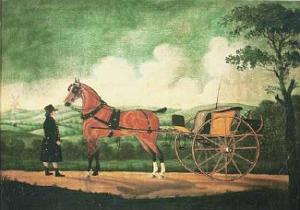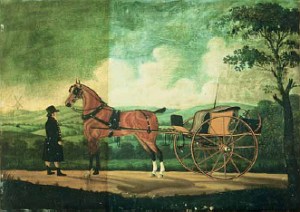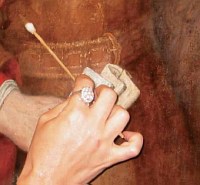AGEING OF PICTURE VARNISHES MADE WITH NATURAL RESINS
John Cordrey (1755-1825)
Horse, Trap and Groom
oil on canvas adhered to board
Acc. No: 1753
Previous Condition: This picture had
been covered with a layer of surface dirt and
discoloured, yellow varnish. Previously a canvas
on a stretcher, but was at some stage glued onto
board. In this process the stretcher tacking
margins were cut off. A natural varnish was
applied. Extensive retouchings were applied to
the sky and small damages were retouched in
the darker areas. A final varnish was then
applied. Varnishes were applied to enhance the
colours of paintings and to protect their surfaces.
Unfortunately these natural varnishes yellow
and embrittle with age. Today,modern chemistry
has improved the quality of conservation
varnishes so that they do not discolour and can
be removed with mild solvents.
Current Treatment: The removal of
surface dirt and yellowed varnish required
careful tests to find an appropriate reagent and
solvent that would safely remove the layers.
Tests were made in areas of the painting to
check the solvent’s response in certain colour
areas and to see that the integrity of the paint
layer was undisturbed. The dirt and the
varnish were removed using small white
cotton swabs on a stick moving in a circular
motion. These were replaced with fresh
cotton once they were slightly discoloured.
This ensured control during the cleaning
process. Small damages were retouched using
reversible colours.
|

Whole front before cleaning.

Whole front during varnish and dirt removal.

Using a cotton swab with solvent to remove discoloured varnish.
|